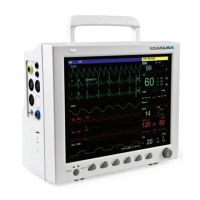Patient Monitor User Manual Monitoring ECG/ RESP
- 108 -
recommended to select Diagnosis mode.
3 Reliable ST monitoring may be influenced in following situations:
You are unable to get a lead with low noise.
If there is arrhythmia such as atrial fibrillation/flutter, the ECG baseline may be
irregular.
The patient is continually performing ventricular paced.
The dominant template can not be obtained for a long time.
The patient has left bundle branch block.
When any of above situations happens, ST monitoring should be switched off.
4 If you use ST analysis, you must adjust the ST measurement point when you start the
monitor. If the patient's heart rate or ECG waveform changes significantly, this will
affect the size of the QT interval, so the ST point must be placed. If the equipotential
or ST points are not set correctly, the ST fragments of the artifacts may be depressed
or raised. Always ensure that the ST measurement point is suitable for your patient.
5 ST values may be affected by such factors as some drugs or metabolic and
conduction disturbances.
6 ST is calculated with a fixed delay from the R position. Changes in heart rate or the
width of QRS may affect ST.
7 If the algorithm triggers self-learning (either manually or automatically), the
calculation of ST segment will be reinitialized
It is available to measure the variance of ST segment with ST analysis at the waveform
tracks for selected lead. The corresponding ST measurement result displays numerically at
ST1 and ST2 in the Parameter Area. The trend can be viewed in table or graphic form.
Measurement unit of ST segment: mV.
Measurement symbol of ST segment: "+" = elevating, "-" = depressing.
Measurement range of ST segment: -2.0 mV to + 2.0 mV.
Pick the ST ANALYSE item in the ECG SETUP menu to access the ST ANALYSE sub-menu
as shown below.

